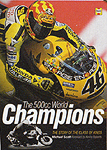|

Rossi's cavalier
riding style - often likened to that of legendary '93 500 champ Kevin
Schwantz - is only eclipsed by his off-track persona, which seems unaffected
by his rise to bona fide superstar status. In Italy his fame has reached
pop star proportions, forcing him to set up home in London.
MotoGP
- The Gang of Fours
2002 Season Review and 2003 Season Preview
14/11/2002
Unmistakable trends have developed throughout the inaugural year of
the combined four-stroke and two-stroke MotoGP World Championship. With
2002 bringing on a brave new era of MotoGP racing, the entire four-stroke
Grand Prix concept has been more successful than anyone could have possibly
expected, more than even its most strident supporters would have thought
imaginable.
Despite the increased cost required to develop and then run the larger
capacity (up to 990cc) four-strokes there has still been no shortage
of takers for the increasing numbers that have found their way onto
the grid this year. Some concepts may have been in gestation longer
than others, some prototypes may have had more money showered over them,
some may have gone for full capacity and power all in one go, but whatever
the tactic the four-strokes have crushed the challenge of the 500cc
two-strokes in virtually every instance.
In terms of race wins, of the 16 rounds this season, all have gone to
four-stroke machines. Not that the ‘strokers have gone down without
a fight. There have been some notable exceptions to the four-strokes
only’ zone at the top of the timesheets and the rostrums, if not
the actual full honour of a 2002 race win.
Most notably the German MotoGP; Sachsenring nearly giving the Gauloises
Yamaha Tech 3 YZR500 rider Olivier Jacque his first premier class victory,
had he not been skittled while leading by his fellow two-stoke pilot,
Honda rider Alex Barros.
Before receiving his own four-stroke, Barros was also the main competition
for 2002 World Champion Valentino Rossi at Assen, when the nimble two-stoke
exploited maneuverability to the max, before being slain by the four-stroke’s
sheer horsepower. Even the three-cylinder KR3s, in the experienced hands
of
Jeremy McWilliams and Nobuatsu Aoki, proved to be capable of running
with the big boys, on the odd occasion, the pinnacle being McWilliams’
pole position at the penultimate round, held at Phillip Island, Australia.
Even in the first contest
of the year, though, three four-strokes out-danced the ‘strokers
in the wet at Suzuka to monopolise the inaugural MotoGP podium. Thus
from the outset the ‘990s’ were proving to be the master
race, partly due to their capacity advantage, and partly due to the
way they deliver that power – with less urgency and greater throttle
control than the tyre-spinning strokes.
Electronics and engine management systems are also far more tuneable
on a four-stroke, an important factor as electronics and ‘fly-by-wire’
systems start to proliferate. With stringent fuel regulations looming
on the horizon, fuel-injection will become even more of an essential
piece of technology, allowing maximum performance within the constraints
of the permitted fuel loads.

Possibly the biggest boon to the all-new prototype four-stokes has been
the rapid advance in tyre technology. As recently as the early months
of this year, there was talk of not even the most experienced tyre companies
being able handle the huge 200bhp plus power outputs of the new breed
of MotoGP machines for more than a few laps at a time. That, as the
resulting improvements in lap and race times prove, was a concern that
rarely reared its head – although still an important tactical
consideration race-on-race – has proved to be no real problem
for the best of the tyre manufacturers.
Paradoxically, the spin-off of all the four-stroke tyre development
has also benefited the lighter two-strokes, allowing them to put in
better race performances and lap times than in previous years. At season
end, the simple numerical balance in the championship has even swung
towards the four-strokes. At the opening round there were seven full-time
factory entries on four-strokes. By the time Valencia rolled along,
the number had risen to 13 – five Yamahas, four Hondas, two Suzukis,
and one each for Aprilia and end-of-season inductees Kawasaki.
In 2003, a brace of Ducatis, two V-five KRs, the growth of and additional
Kawasaki and Aprilia, and an as yet undetermined number of Hondas and
Yamahas will very possibly make for an all-enveloping four-stroke grid.
This looming fact, after only one season, is the most clear-cut vindication
that the four-stroke experiment has been a unanimously well-received
idea. From Barros winning at his first attempt on Honda’s four-stroke
to the blanket four-stroke podium places at 10 of the 15 races thus
far, the fours have been an instant hit.
For the factories,
with road bike model ranges almost exclusively devoid of two-strokes
the attraction of going four-stroke has been a way to combine R&D
and promotions budgets in a prototype class, allowing new technologies
to be tried before they filter down to road bikes. In a manufacturer
led sport like bike racing this has been the predominant factor in the
instigation of the current rules, but the stopwatch has been the ultimate
judge. Based on the rapidly accumulating evidence, the verdict has found
in favour of the new titans of the
racing arena, the MotoGP four-strokes. -editorial curtesy Yamaha-Racing.com
Return
to The Pit Board Index Page
|
Rossi
Printography
An exciting look at the world's best motorcycle
roadracer.
Just
Click to Order Online!

The
Valentino Rossi Story

500cc
World Champs

Ripped
Pavement
Calendar
|
